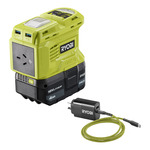Part of the OnePass deal. Will be available to non OnePass members from the 18th.
This is a good deal for what you get for $119. Considering the battery alone has RRP of $149. The only other way to buy the topper is in a kit for $149 that does not include a battery, but has a 12v car lighter socket type charger. https://www.bunnings.com.au/ryobi-18v-one-150w-inverter-and-…
You get the 150W battery topper,
A 4.0AH battery,
A 65W USB wall charger.
A 1M USB-C to USB-C Cable,
The battery topper is a newer model but I can only assume it is still a modified sine wave.
It has 1 x USB-C PD port 30W, (Credit to Clear for spotting it). Plus 2 x USB-A ports 15W each, a 150W 240v outlet and an led light. Pic of the USB-C port, https://files.ozbargain.com.au/upload/309005/124117/ryobi_in…
Here is a link to access the only manual I could find (it's from a different kit but the topper itself is the same model) Just scroll down a bit and click on manual.
https://www.ryobi.com.au/products/portable-power/18v-one-150…
Fairly widely available in reasonable numbers with not too many store nil stock. https://bunnings.youinstock.com.au/search/0879021


Ozito don't have one yet.